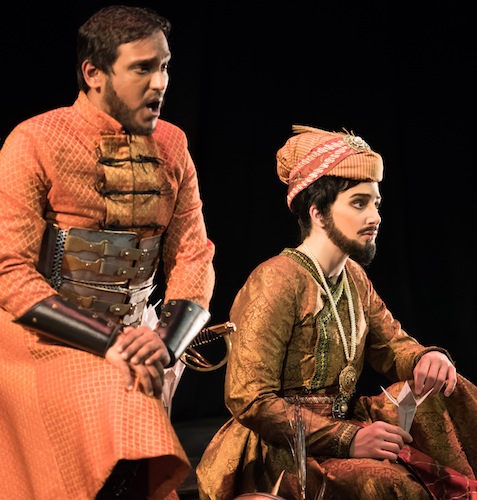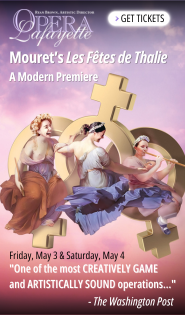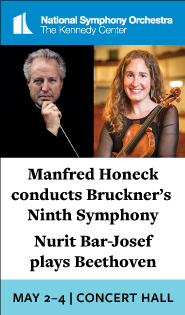Opera Lafayette’s double-bill delivers a striking cross-cultural success

Asitha Tennekoon and Allegra De Vita in Opera Lafayette’s “Erminia” by Alessandro Scarlatti. Photo: Louis Forget
Opera Lafayette combined two excellent rarities of the Italian Baroque for its latest program, heard on Tuesday at the Kennedy Center Terrace Theater. Both of these mini-delights, presented in fully staged versions, are on stories drawn from Tasso’s Gerusalemme liberata, a fantasy epic of sorcerers and warrior-maidens set during the First Crusade.
This production introduced a twist, transposing the stories from the Muslim-Christian conflict in the Holy Land to the struggle between the Muslim Mughals against the Hindu Marathas in India in the 18th century.
In Alessandro Scarlatti’s Erminia, completed in 1723, mezzo-soprano Julia Dawson deployed a rich, viscous tone as the title character, a princess who betrays her city for love of the invading knight Tancredi. Her melismas sparkled with clean accuracy, and the low range in particular extended into the depths in beautiful, surprising ways. The role has soprano heights, however, perhaps more suited to a soprano, where Dawson struggled a bit with intonation and placement.
Erminia, devastated to learn that Tancredi is in love with the warrior-maiden Clorinda, sneaks out of the city in Clorinda’s armor to find him. Bass-baritone André Courville sounded solid in the arias of Pastore, the shepherd who takes pity on the fleeing princess. The robust quality of Courville’s voice, strong and even overpowering at times, became wobbly and less focused in the recitatives.
Asitha Tennekoon’s tenor voice initially came across as nervous and nasal in tone as Polidoro, one of the knights pursuing Clorinda/Erminia. He seemed to relax in the fine performance of his first aria, where the solo trumpet obbligato vied for glory, as well as in subsequent pieces.
The most striking performance was Allegra De Vita’s astounding trouser-role turn as Tancredi, complete with beard and utterly convincing male movement. Coming just two weeks after playing a radically different character in Missy Mazzoli’s Proving Up, this young singer showed extraordinary dramatic range in her Opera Lafayette debut. With a smooth legato finish in copious runs, extraordinary embellishments, and some laser-precise top notes, she led the way vocally as well.
Performed for a noble wedding in Naples, Erminia is a serenata, more of a dramatic cantata than an opera, and only the first of the two acts survives in the remaining scores of the work. It worked surprisingly well in this staged version, directed simply but effectively by Richard Gammon. A lacy wooden set piece (scenic design by Richard Ouellette, used in both works) set the stage of the pastoral clearing, augmented by some stands of white flowers.
The shift of setting to India was more apparent in Francesco Geminiani’s La forêt enchantée, reconceived here in line with this instrumental piece’s origins as the accompaniment to a dramatic pantomime in the machine-theater of Giovanni Nicolo Servandoni in Paris in 1754. (For more information, refer to a certain doctoral dissertation.) The performers of the Kalanidhi Dance troupe told the story, with Mughal lords fighting against spirits led by a Maratha wizard, in charming choreography by Anuradha Nehru and Chitra Kalyandurg, based in the kuchipudi form of Indian classical dance.
The most evocative scenes featured the troupe’s six women as Maratha spirits, in veils and with fearsome handsome gestures, often illuminated in macabre colors (lighting designed by Rob Siler, rich costumes by Meriem Bahri). Saisantosh Radhakrishnan’s devilish turn as Uday Singh (replacing the Muslim sorcerer Ismeno) was matched by the virile movements of Puneet Panda as the valiant Mughal warrior Rustam Zaman, who ultimately breaks the spell on the enchanted forest.
Seated snugly in the renovated pit of the Terrace Theater, the Opera Lafayette Orchestra excelled in the Scarlatti work, with particularly strong contributions from the paired recorders and oboes in the offstage shepherd music. Ryan Brown’s conducting faltered only slightly in that scene, in some minor coordination issues with a choral quartet in the wings. When Brown took up his violin to play the solo parts in the Geminiani piece, he often rushed ahead of his ensemble, less able to keep the group together without his hands free.
This production will be repeated 7:30 p.m. Wednesday at the Kennedy Center and 7:30 p.m. Friday at John Jay College in New York. operalafayette.org


